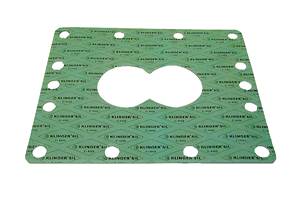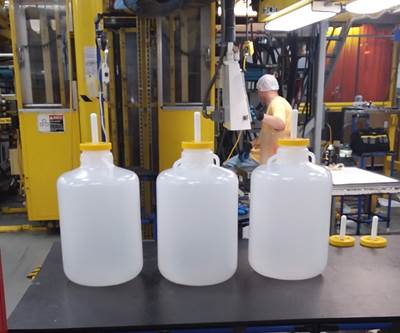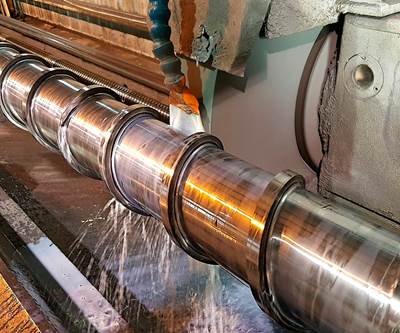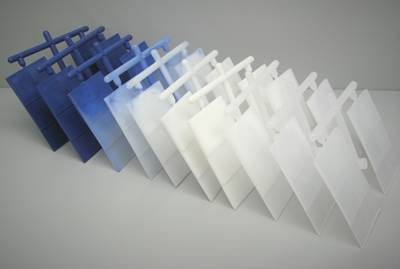In today’s competitive processing environment, every minute counts. Time is money, and faster color and resin changeovers can minimize downtime and reduce scrap and waste to give processors a competitive advantage to optimize current business as well as win new business. Paying close attention to the care and condition of your screw and barrel can yield dividends for processors.
It’s difficult to compensate for the shortcomings of a worn screw or barrel, so maintaining your equipment is vital. The screw and barrel for an extrusion or injection process are often taken for granted. Routine preventive maintenance (PM) is often sacrificed to meet current demand, and while short-term needs are met, the long-term impact of deferring maintenance can be devastating to your business. One means of improving the PM of both screw and barrel is the regular use of a high-quality commercial purging compound (CPC).
Screw and barrel manufacturer Reiloy USA has a Preventative Maintenance Handbook that can be used by processors as a reference guide for building your PM program. It highlights some of the many factors that influence the length of time and degree of wear on your screw and barrel systems, such as:
• Type of plastic—is it corrosive like PVC, or abrasive because of glass or mineral fillers?
• Type of alloy used to construct the screw and barrel.
• Presence or absence of a hardened coating on the screw.
• Process settings—temperature range, rpm, pressure.
• Alignment of screw to barrel, proper clearances, and frequency of calibration.
It’s difficult to compensate for the shortcomings of a worn screw or barrel, so maintaining your equipment is vital.
A structured, disciplined PM program will measure the life of the screw, barrel and valve for the resins being processed. Every PM program should include educating employees to understand the different types of wear and the causes of that wear, plus instructions for measuring wear and guidelines for when to repair or replace components.
When running mostly reinforced resins, a PM program should be set up for inspecting every six months until wear trends have been established for the screw, barrel, and valve. A PM program when running unfilled resins should be set up on an annual basis until the wear trends are established. When it is known how long a screw, barrel and valve should last in a given process, steps can be taken to make sure repairs or replacements can be made in a timely manner to reduce or eliminate downtime.
Understanding the wear on a component also provides the opportunity to make design changes so that replacements will run longer. PM programs provide the opportunity to track component wear life and help explain variations in a process over time. As components wear, most likely changes will be seen in one or more of the following areas: overall cycle times (standards), scrap rates, electric consumption and downtime.
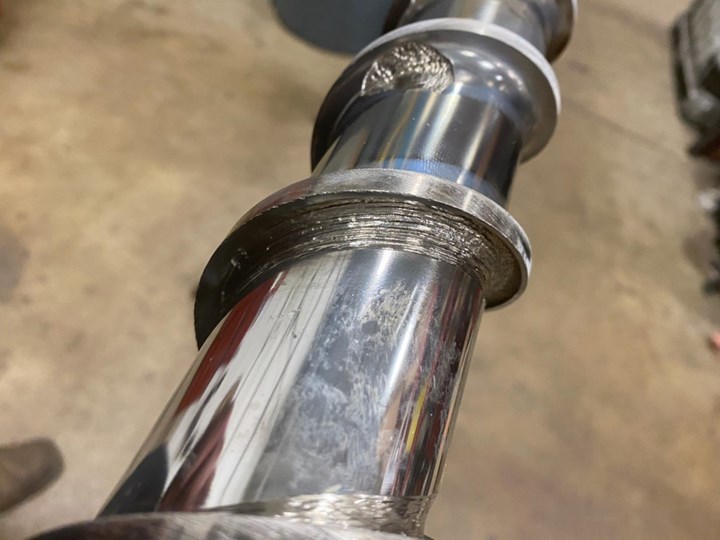
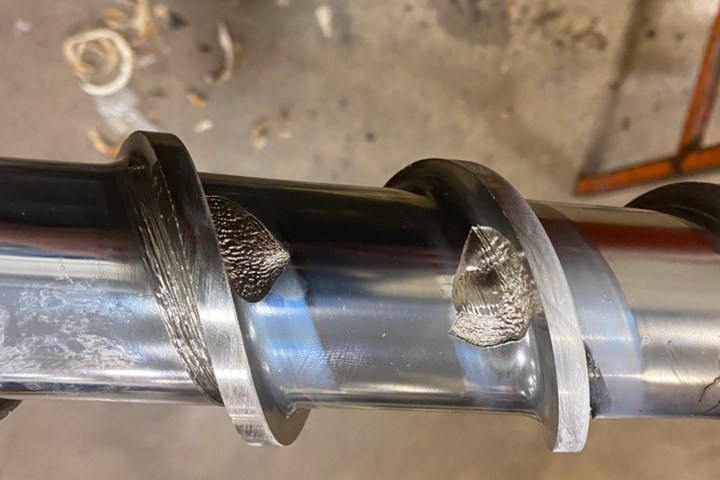
Any variance in the standards set on these points can be directly related to wear on components. A strong PM program can minimize each of these. Barrel and screw wear is relatively easy to measure if the necessary equipment is used. After proper cleaning and cooling to room temperature, wear can be measured and recorded on inspection reports and required repair or replacement steps can be evaluated. Utilizing a commercial purging compound (CPC) to clean the screw and barrel before pulling will greatly increase the efficiency of the screw-pull process. Some CPCs are designed specifically for this purpose.
How Purging Fits in
While minimal and normal screw and barrel wear may be compensated for with process adjustments, at some point the wear will negatively impact your throughput. If you implement a sound PM plan, you can increase the lifespan of your screw and barrel as well as optimize your production over that time period. Pulling a screw on a small extruder is usually simple, but when the size increases, or you’re dealing with an injection unit, the complexity escalates, and your expected downtime can become lengthy. Working with your machine OEM, or screw and barrel provider, you can design a sensible PM plan for your operation. Purging with a proper CPC should be an integral part of that plan.
Utilizing a commercial purging compound (CPC) to clean the screw and barrel before pulling will greatly increase the efficiency of the screw-pull process.
The right purging compound may extend the lifespan of your screw and barrel as well as help you to speed color and resin transitions during production. A technically competent CPC provider can work with the processor to match the proper grade to the resin, temperature, and process type for optimal performance. Thorough elimination of carbon buildup (black specks), color, resin, fillers and other residues is critical to your productivity and the upkeep of your screw and barrel. For shutdown periods you can identify a heat-stable CPC that will seal your system and prevent oxidation from occurring. This prevents black specks during startup and processing.
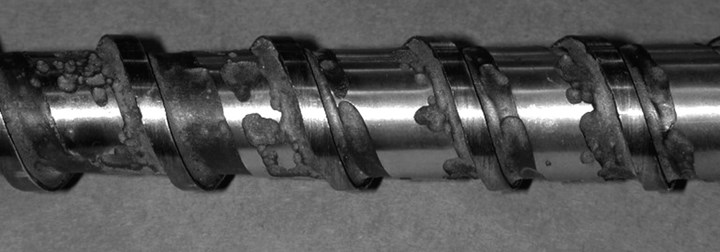 CPCs are designed to remove resin, color, contamination, and carbon deposits. Always remove corrosive and filled resins before idling equipment to avoid corrosive wear, as shown here.
CPCs are designed to remove resin, color, contamination, and carbon deposits. Always remove corrosive and filled resins before idling equipment to avoid corrosive wear, as shown here.• Commercial purging compounds are designed to remove resin, color, contamination, and carbon deposits. (Reiloy USA recommends always removing corrosive and filled resins before idling equipment.)
• Some CPCs have a low affinity for metal, making elimination more effective.
• Some CPCs are thermally stable and thus excellent for shutdown and sealing to minimize oxidation.
• Some CPCs cool and shrink. This will help pull any built-up material and carbon away from metal surfaces. Doing this routinely will prevent buildup and help avoid unnecessary screw pulls for manual cleaning.
• Some CPCs are designed to expand into the negative flow areas of your process, removing residual material that’s often left behind when using regrind or resin to transition between materials or colors.
• Typically, CPCs are a better value for purging than virgin or regrind. This is due to their greater effectiveness and the relatively limited amount required to clean the system. A net lower “cost-to-purge” is achieved.
Processors can extend the lifespan of their capital equipment and capture significant improvements in productivity by implementing recommendations from their screw and barrel provider for regular PM, coupled with routine use of a high-quality CPC designed for their specific needs.
About the Authors:
Randy Wise has been in the plastics industry for 35 years, 28 of them with Reiloy USA (formerly Westland), Maize, Kans., working with both OEM and processor accounts. Contact: 800-247-1144; rwise@reiloyusa.com; reiloyusa.com.
Bob Grzegorek is global technical services manager for the Dyna-Purge Division of Shuman Plastics. A disciple of Scientific Injection Molding, he has completed extensive course work with RJG Technologies and John Bozzelli. Grzegorek spent his early career working for custom injection molders Ethyl Molded Products and Jones Plastics and Engineering, as well as automotive Tier One supplier GECOM. He has also held positions as plant manager with Newell Rubbermaid, Reflex and Allen Extruders. Contact: 317-600-9861; rgrzegorek@dynapurge.com; shuman-plastics.com.
Related Content
PolySource Enters into Exclusive Distribution Partnership with Asaclean Purging Compounds
This strategic alliance is expected to enhance resin distribution efficiency and customer success.
Read MoreRun Lots of Colors? Time to Consider a Commercial Purging Compound
Processors who use commercial purging compounds will see a reduction in scrap levels, machine downtime and overall cost.
Read More10 Ways to Improve Twin-Screw Compounding Performance
There are many techniques known to operators and plant engineers for increasing the performance of a twin-screw compounding extruder.
Read MoreNeutrex Names John R. Haag President, CEO
Haag has played an integral role in the founding of Neutrex in 1992 and served the company for three decades as general counsel.
Read MoreRead Next
Follow These Steps to Purge Accumulator-Head Blow Molders
Preventive purging with a commercial product between resins or colors and during normal shutdown and startup cycles can prevent excessive loss of resin and production time.
Read MoreScrew Wear: Understanding Causes, Effects, and Solutions
Here’s how to find out what’s happening to your screw and what to do about it.
Read MoreBe Proactive in Your Purging Program
True, it can be tough to take a machine out of production, but a purging maintenance program should be thought of as a direct line to cost savings.
Read More

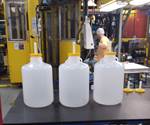
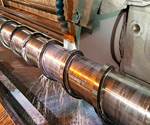
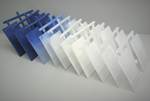







.png;maxWidth=300;quality=90)













